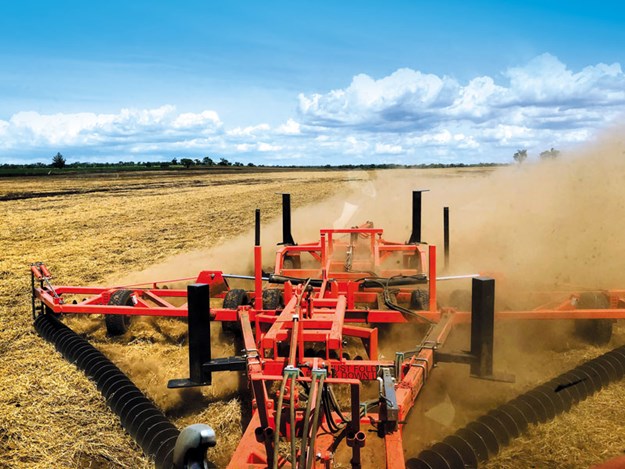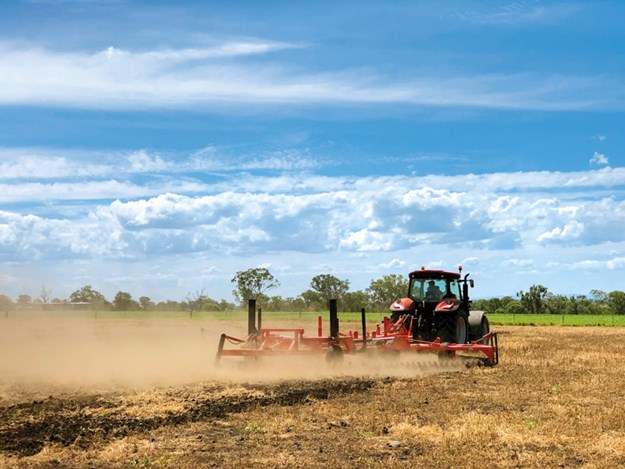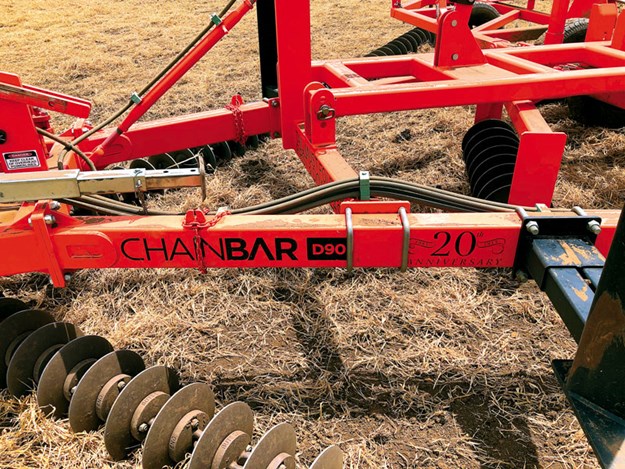Test: Brookfield D90 Chainbar
Farm Trader takes a look at a piece of kit from across the ditch - the Brookfield D90 Chainbar
 |
|
Thanks to clever design, a 150hp tractor can handle the 9.2m machine
|
Farm Trader’s Jaiden Drought managed a final trip across the ditch prior to lockdown for a look at a piece of kit specifically designed for Australian soil conditions: the Brookfield Chainbar. Teaming up with his Australian counterpart Harrison Hunkin, the pair discovered a solid but versatile machine that makes short work of drought-hardened soils.
Back in the heady days when we could freely travel without difficulty, we managed a trip to Toowoomba, a lovely Queensland town famed for its rich volcanic soil, to check out a famous Aussie cultivation tool, the Brookfield Chainbar.
This got Harrison’s adrenalin levels up, with the D90 Chainbar hooked up to a large McCormick tractor and a big paddock to play in. The farmer was also happy, as we couldn’t get anywhere near his fences; his valuable farm infrastructure was safe!
How does it work?
 |
|
The Chainbar range runs from the four-metre D40 to the 18-metre D185D |
For those unfamiliar with the big orange machine or what a Chainbar does, the easiest way to explain how it works is this: imagine discs linked together in four sections to make a square. Then imagine the square is turned 45 degrees so that one of the corners is facing the back of the tractor.
This then allows each side of the ‘square’ to be pulled at 45 degrees creating a chopping and cutting action. Naturally, there are a number of options for working width, starting at the D40, which is a four-metre folding version, right up to the D185D, which is a (60ft) 18.5-metre, 13.5-tonne beast that, when folded, looks like a combination of a Transformer and Steve Irwin with a large python draped around his shoulders.
In terms of the design itself, it’s solid yet simple and very clever in the way that it all folds. All nine models come in under five metres for transport, which, given its up to 18.5-metre working width, is an engineering marvel in itself.
Made for Aussie conditions
 |
|
The black uprights hold the chain/discs in place during transport
|
Australian cultivation differs from many other parts of the world. Fortunately for us, we enjoy a trans-Tasman machinery relationship, which usually means what works well over there, works well here, and vice versa.
Australia has vast, expansive paddocks as well as often-challenging hard soil conditions, compounded by crippling droughts. The Australian-designed and built Chainbar offers a cost-effective solution.
During our test, we were pulling the D90, which is a 30ft (9.2 metres) Brookfield, with a 150hp (112kW) tractor. If you were doing more traditional cultivation types like we see back home here in New Zealand or in many European countries, you would have that sized tractor for a three-metre machine.
The other major benefit of the Chainbar, apart from low horsepower requirements per metre working width, is the simplicity of the machine from an R&M and cost of ownership prospective.
The Chainbar is highly efficient, covering large areas in a short space of time. For many, it’s also an effective weed control tool, both from a cultivation perspective and to incorporate chemicals so they have good contact with the weeds and get a much cleaner, more even kill.
Optional extras include a small seed applicator so you can seed while you cultivate, or a chemical application kit, so you can spray weeds and incorporate it for a truly one pass machine.
The type of tough drought-riddled forage or crop residue that it encounters would be considered difficult cultivation conditions, particularly for machines with poor trash flow. Due to the weight of the machine, the Chainbar simply cuts through trash. It has excellent penetration in hard ground.
 |
|
The Chainbar creates enough tilth for germination without losing large amounts of valuable moisture
|
While it doesn’t create a huge amount of soil movement, it does create enough tilth to give good seed to soil contact while not exposing too much soil to lose any of that valuable moisture or expose it to wind erosion. For many, what little topsoil there is, is the most valuable asset on the farm.
Chain option
 |
|
The disc joins and pivoting mounting system allow the chain to snake its way over the ground
|
The Brookfield Chainbar has seven different chain options to match the type of tillage you’re trying to achieve, as well as the many varying soil types. The different chain types offer different disc types, the number of discs, and the weight of the chain.
 |
|
The barley stubble offered little resistance for the Brookfield Chainbar
|
Also, more importantly for a lot of people, the horsepower required to pull varies considerably. On the D90 model we tested, the least aggressive PC 18 chain only requires 90hp (67kW) to pull. If we had the most aggressive DC90 chain that would require more than 315hp (235kW).
 |
|
The 20th anniversary sticker on the D90 suggests this is not their first rodeo
|
To put that in perspective, if you had the Big Daddy DC185D with the DC 90 chain, it would take one of the most powerful tractors in the world to pull something like that with more than 630hp (470kW) required.
But with such a wide working width, hectare efficiency would be almost incomparable to anything else on the market. Given the vast areas often needed to be worked, the Chainbar is in a league of its own.
Pros
- Vast working width
- Options to suit all tractor power, soil type, and conditions
- Simple robust design
- Little to go wrong
- Good trash flow
- Heavy nature of the chain gives good soil penetration
Cons
- It takes two passes with the Chainbar to create the levelling/ tilth creation of more traditional disc machines. This will be at the expense of moisture, which is often undesirable
Find farm machinery for sale in NZ
Keep up to date in the industry by signing up to Farm Trader's free newsletter or liking us on Facebook











.jpg)
.jpg)
.jpg)
.jpg)

